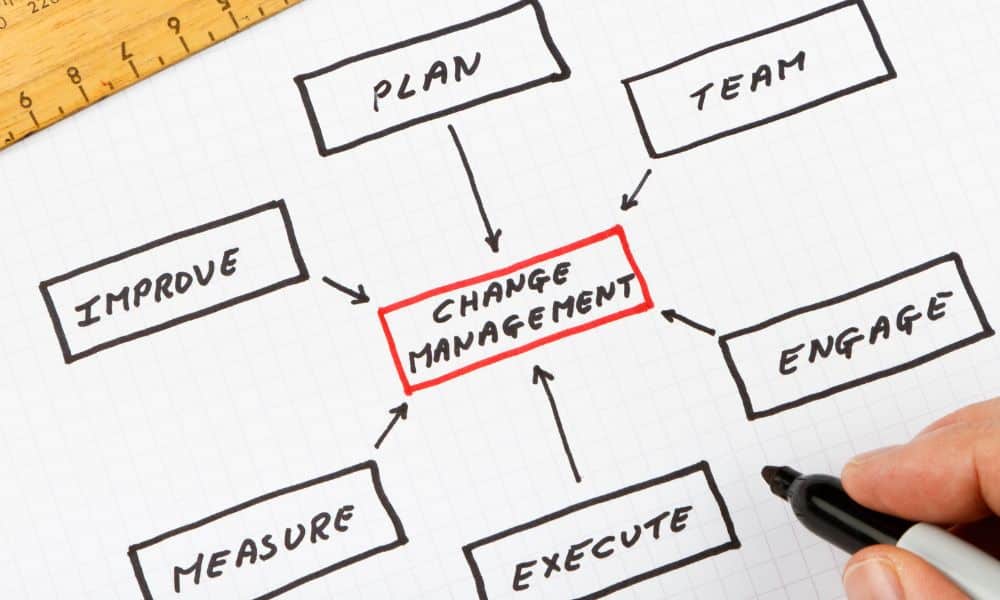When a change is happening, getting employees ready for it is essential. They need to understand why that change has to happen and what it means for them.
Research among 2,500 managers indicates a minimum of 30% performance boost due to effective change management efforts. In big projects, the return on investment was 6.5 times higher when an effective change management approach was used.
“It is not the strongest of the species that survives, nor the most intelligent that survives. It is the one that is most adaptable to change.” – Charles Darwin.
To achieve successful change management, business leaders in your organization must communicate the change early and often. It should also provide training and support and be available to answer questions. The organization should also reward the staff who succeed. A clear business strategy should be integrated to guide employees through transitions effectively.
Here, you can look closely at the best practices to help you manage effective change.
Embracing Change: A Journey Through Organizational Transformation
Organizational change is a crucial aspect of any business, as it enables companies to adapt to shifting market conditions, technological advancements, and evolving customer needs. Effective change management is essential for successful organizational change, as it helps to minimize resistance, ensure a smooth transition, and achieve desired business outcomes.
In today’s fast-paced business environment, the ability to embrace change is a key determinant of business success. Companies that can effectively manage change are better positioned to respond to external pressures, innovate, and maintain a competitive edge. Change management involves a structured approach to transitioning individuals, teams, and organizations from a current state to a desired future state. This process is vital for aligning internal processes with new business strategies and ensuring that all employees understand and support the changes.
By implementing effective change management practices, organizations can not only navigate the complexities of change but also leverage it as an opportunity for growth and improvement. This section will explore the importance of organizational change and the role of change management in driving business success.
Get Involved In Change Management Early On

Lack of effective communication can be a serious obstacle to a successful organizational change. Without building transparency and awareness of the organizational goals and projects, there can be a lot of confusion and misalignment.
So, companies are spending more time and necessary resources to encourage employees, clarify roles, and communicate expectations.
A recent Prosci Benchmarking report shows that earlier change management involvement can benefit employees. One of the best practices in change management is having capable change leaders to handle the transition.
Also known as an advocate of change, a change agent is an individual who acts as a catalyst for the entire change management project. They help organize the process and transform it to benefit the rest of the staff.
The change agent enables, promotes, and supports the company’s change implementation. When you allocate qualified change management teams, you are helping participants create backup plans and anticipate obstacles.
Qualified individuals can keep communication open. They can help eliminate rework that would come with the change process. They engage employees early on, support them, and help them better prepare for the change. Change managers play a crucial role in crafting strategic plans, embedding changes in company culture, and ensuring successful transitions.
Besides, every organization has risk tolerance, culture, and regulatory requirements. These are all factors you should consider in your change management strategies. A qualified team understands your company’s risk tolerance and can plan accordingly.
How to Choose the Right Change Agents?

There are external and internal change agents. An internal agent is often a team member like a senior executive, manager, or HR professional. They understand human intervention, behavioral science, and organization development.
An external agent is a third-party practitioner or outside consultant with similar experience. Even though external agents offer valuable feedback from a fresh perspective, they may not be the best choice when working with fewer employees. Their presence can threaten existing staff.
Some of the factors below can help you select the right agent to find the best practices for a successful change management process that integrates seamlessly into the company culture. The agent must have the following:
- Strong collaboration, problem-solving, and communication skills.
- The skills and experience to prioritize key events and ensure employees stay engaged and motivated.
- Drive and full dedication to achieving the best results.
- The time management and patience to work under pressure and remain positive with employees.
Understanding the Change Management Process
The change management process involves a series of key steps, including planning, implementation, and sustainment. It requires a structured approach, clear communication, and the involvement of key stakeholders, including employees, senior managers, and department heads. A well-planned change management process helps to ensure that changes are implemented efficiently, effectively, and with minimal disruption to the organization.
The first step in the change management process is to identify the need for change and develop a detailed plan. This plan should outline the goals, objectives, and scope of the change initiative, as well as the resources required to achieve them. It is essential to involve key stakeholders in the planning phase to ensure their buy-in and support.
Once the plan is in place, the next step is to implement the change. This involves executing the plan, communicating the changes to all employees, and providing the necessary training and support. Clear and consistent communication is crucial during this phase to ensure that everyone understands the changes and their role in the process.
After the changes have been implemented, the final step is to sustain the change. This involves monitoring the progress, evaluating the outcomes, and making any necessary adjustments. Continuous improvement is key to ensuring that the changes are effective and sustainable in the long term.
In this section, we will delve into the details of the change management process and explore its various aspects, including the importance of employee engagement, communication, and continuous improvement.
Developing a Change Management Strategy
A change management strategy is a critical component of any organizational change initiative. It outlines the approach, tactics, and resources required to implement change and achieve desired business outcomes. A successful change management strategy involves a deep understanding of the organization, its culture, and its people.
The first step in developing a change management strategy is to conduct a thorough analysis of the change initiative. This includes identifying the goals and objectives, assessing the potential impact on employees, customers, and other stakeholders, and determining the resources required to implement the change.
Employee participation is a key element of a successful change management strategy. Involving employees in the planning and implementation process helps to ensure their buy-in and support. It is also important to secure leadership buy-in, as strong leadership is essential for driving the change initiative and maintaining momentum.
Effective communication is another critical component of a change management strategy. Clear and consistent communication helps to ensure that all employees understand the changes and their role in the process. It also helps to address any concerns or resistance that may arise.
In this section, we will discuss the key elements of a change management strategy, including the importance of employee participation, leadership buy-in, and effective communication.
Use Game Mechanics to Influence Performance
Changes in the workplace are constantly happening, especially in technology. The latest technological advances are driving the way corporations today communicate and collaborate. Including the way organizations are structured. Radical change has become prevalent but unsuccessful.
Here is a fact: Employees are a crucial component and valuable asset of every organization. When employees become swapped and overwhelmed by drastic change, this can affect the entire company’s ability to function – let alone adapt to the change.
A survey shows 96% of organizations reported they underwent business transformations. However, just 47% of those evaluated estimated to obtain sustainable value from these efforts. Experts believe that 70% of change efforts do not succeed mainly because employees resist change.
Most people resist change because they don’t want to leave their comfort zone. Some prefer to play it safe, while others prefer the simplicity of working with old-school methods.
Some of the best practices of change management are to invest in new technology, like gamification. Gamification is a strong tool for transformational change. The new norm can take your change management plan to a completely different level. It is essential to continually monitor and analyze the effects of gamification to ensure success.
Gamification is used for providing feedback, supporting better user engagement, and to track progress.
How Can Gamification Help With Change Management?
Over 70% of the Global 2000 organizations have at least a single gamified application to overcome different business challenges. Gamification is used for providing feedback and supporting better user engagement.
Through digital transformation, companies can constantly adapt to an unpredictable and rapidly evolving environment. So, what makes gamified training some of the change management best practices?

Adding gamified elements to training can boost motivation to 83% and decrease boredom to just 10%. This, in turn, significantly enhances employee performance by fostering a competitive and engaging environment.
Gamification basically means turning any work activity into a more game-like experience that motivates employees. For example, you can use gamification for the following things.
Change work habits
Gamification uses game mechanics to inspire behavioral change and form new habits. Some of these game mechanics include leaderboards, achievements, points, etc. It can help employees prepare, test, and learn organizational change. You can measure the employees’ abilities. For example, how well they can engage stakeholders, execute, plan, or sustain change.
Explain the new change through gamified learning
Gamification in learning uses game-based elements like badges, teamwork, leveling system, and scoreboards to boost engagement and simplify learning.
Support that change
You can use gamification as the best practice in change management to help employees overcome potential challenges. Employees get rewards for learning and collaboration.
Companies can use gamification to create a structured approach to change management. They can use the new tool to offer more detail and reduce the learning curve.
That’s because employees understand easier when they use gamified elements. They can get a clear vision of the company’s goal, visualize their success, and earn badges, achievements, and points, all of which make implementing change management strategies easier.
Based on a 2019 survey, 89% of employees stated gamification made them feel more productive at work. Roughly 89% of people evaluated stated they could increase their productivity if their work were more gamified.
Deploy Smaller Releases to Ensure Minimal Disruption
Change management involves preparing, planning, and assessing for one or more changes. One common mistake many companies make is to release all the changes at once. This is to save time and resources on organizational change management. But, it can backfire.
So, what is the best practice in change management? It is essential to keep things simple. The organization’s employees should clearly understand the changes they want to implement.
With every new project, you should consider guiding organizational change. You can do that by doing frequent and smaller releases. Find the ones that have the highest odds of success. Utilize multiple channels to effectively showcase early wins and productivity improvements.
Smaller releases make it easier for employees to navigate the different change management models. It also helps them avoid areas of conflict.
Here is another option:
- Test the change out on smaller groups first.
- See how your employees react to the change and whether or not it can prove effective.
- Document everything that comes with successful change management.
How Long Does the Change Management Process Take?

The change process can take anywhere from a couple of weeks to a couple of years to implement. The scope of the transition, including the integration of new systems, and the organization’s size significantly affect how long the process takes. The bigger the organization, the more complex the change process. It is also crucial to communicate the personal impacts of these changes to employees effectively.
Don’t know if your change management strategies worked for your current business model? Here are a couple of examples that are a clear sign the transition was successful:
- The amount of work-related incidents sees a steady decline.
- Sales numbers keep increasing.
- The amount of repeat customers goes up.
- Engagement and social sharing are increasing.
An efficient change management process involves five steps. These include:
Step 1
Identifying a goal and developing a strategy. The goals should be relevant, time-bound, specific, measurable, and attainable.
Step 2
Estimating how the change will affect the entire organization. Assess the company’s history of past transactions and get an accurate idea of the business segments the change can affect.
Step 3
Creating a strategy. Evaluate the gap between the necessary level of performance and the current company level. This can help you see if training is needed to meet those goals.
Step 4
Implementing the plan. Put the easiest objectives first. This helps improve confidence and maintain momentum.
Step 5
Doing a post-transition review. Measure the degree of change compared to the initial goals. All employees should understand the changes.
Overcoming Resistance to Change
Resistance to change is a common challenge faced by organizations undergoing significant change. It can arise from various sources, including employees, customers, and other stakeholders. To overcome resistance, organizations must develop a comprehensive change management plan that addresses the concerns and needs of all stakeholders.
One effective strategy for overcoming resistance to change is to communicate the reasons for the change clearly and consistently. Employees need to understand why the change is necessary and how it will benefit them and the organization. Providing training and support can also help to alleviate concerns and build confidence in the new processes.
Encouraging employee participation and engagement is another important strategy for overcoming resistance. Involving employees in the planning and implementation process helps to ensure their buy-in and support. It also provides an opportunity for employees to voice their concerns and contribute to the success of the change initiative.
The use of game mechanics, experiential learning, and intrinsic motivation can also be effective in overcoming resistance to change. Gamification leverages game elements to motivate employees and encourage participation. Experiential learning provides hands-on experience with the new processes, helping employees to understand and adapt to the changes. Intrinsic motivation focuses on the internal rewards and satisfaction that employees gain from embracing change.
In this section, we will explore the causes of resistance to change and discuss effective strategies for overcoming it, including the use of game mechanics, experiential learning, and intrinsic motivation.
Show Appreciation for Even the Smallest Achievements
Managing organizational change is just as important as implementing it. After you start change management processes, you must keep celebrating short term wins and big achievements.
But most importantly, you should celebrate the individuals who accomplished those wins.

Showing appreciation can boost morale and inspire more people to accomplish organizational changes actively. When people feel appreciated, it can make the transition go smoothly and speed up the process. Professional development opportunities can also play a crucial role in facilitating this transition.
Incorporate recognition into every gathering or meeting. Make sure that supervisors and management are on the lookout for things to celebrate. You can also use this strategy to provide people with incentives that can inspire them to accept different challenges.
How to Make Employees Feel Appreciated?
There are creative ways you can reward and show appreciation to employees when managing change. Here are some of the top ways organizations are making people feel valued.
- Add a Corporate Gamification System
Every staff member can claim tasks that they choose. This task can reward them with points upon completion. The staff can redeem these points for corporate rewards. Such as more work-from-home days or additional vacation.
This sort of digital transformation is a practical way of allowing people to feel appreciated and offer meaningful results.
- Let Staff Receive and Give “Props”
Big companies like to show their appreciation by recognizing staff members daily. They can do that by setting aside some time at the end of each day to give props. Different members of the team can give props to a specific employee.
This helps create a positive atmosphere and respect for teamwork. When people are more respected for their contributions in front of the entire team, they are more likely to strive for more.
- Treat the Staff
Bring foods, like pizza or doughnuts, from time to time on the company dime. This is an excellent way of showing appreciation when making complex organizational changes. Food parties or lunches offer numerous benefits. For instance, the staff can socialize and build interpersonal relationships.
- Show Gratitude Online
If your organization is using social media, you can use the new technology. Recognize the staff on your social channels when you implement and manage change. Posts can include events that highlight the staff’s achievement, their photo, or their latest contribution to projects.
- Link the Rewards to Your Organization
Let’s say that your organization is producing and selling golf equipment. Once a month, every team (product, support, marketing, etc.) presents what the staff has accomplished during that month.
The staff can then vote on which team had the most significant impact on achieving the yearly goal. The winning team can get a visit to a mini-golf course while building a close connection with the customers they serve. This is an excellent strategy to use when focusing on organizational change management.
Sustaining Change
Sustaining change is a critical aspect of the change management process. It requires a long-term commitment to continuous improvement, monitoring, and evaluation. Organizations must continually assess the effectiveness of their change initiatives and make adjustments as needed.
Tracking progress is essential for sustaining change. Key performance indicators (KPIs) can be used to measure the success of the change initiatives and identify areas for improvement. Regular team meetings provide an opportunity to review progress, discuss challenges, and celebrate successes.
Employee feedback is another important tool for sustaining change. Regularly soliciting feedback from employees helps to identify any issues or concerns and provides valuable insights for continuous improvement. It also helps to ensure that employees feel heard and valued, which can increase their commitment to the change initiative.
Continuous improvement is key to ensuring that the changes are effective and sustainable in the long term. This involves regularly evaluating the outcomes of the change initiatives and making any necessary adjustments. By following these strategies, organizations can ensure that their change initiatives are successful and sustainable, leading to long-term business success and growth.
In this section, we will discuss the importance of sustaining change and explore strategies for maintaining momentum, including the use of key performance indicators, employee feedback, and regular team meetings.
Shift the Burden of Change
Even though the staff can quickly oppose change, especially when it is disruptive and radical, they can adapt even faster to new environments. Your organization can make use of this adaptability by creating a new structure.

The new organizational structure should have new values, workflows, and processes. You can then gradually transfer the staff from the old one. This strategic approach offers substantial benefits when you need a transformative and radical organizational change.
Instead of putting all the work on upper management to coerce and entice many employees, you can shift the burden of change to the staff in the new organization. When they get there, the staff are faced with two options: adapt or get left behind. Employees prefer to receive information about personal impacts directly from their supervisors, highlighting the need for tailored communication strategies.
Take the First Step
The business world is constantly evolving. That’s why organizations must keep adapting and advancing. Change management can help speed up transformations and drive successful outcomes for companies, especially when employees receive communications about the personal impacts of change directly from their supervisors. But, without effective change initiatives, you will be off to a rocky start.
In this guide, you can find the best practices in change management that can help your organization evolve in a timely manner. All the tips here are tailored toward different industries to facilitate the period of effective change management.
If you want to add gamification to change management, our team at can help. Change management gamification help encourage employee adoption and engagement.
Gamification is often seen as a change management innovation since it crosses over with workplace learning, culture building, and onboarding. It is a powerful tool in enhancing employee engagement and facilitating smoother transitions during organizational changes. This makes it a valuable tool in human resource management. Book a demo with us today!
Be sure to check out our Linkedin page and contact us today.





